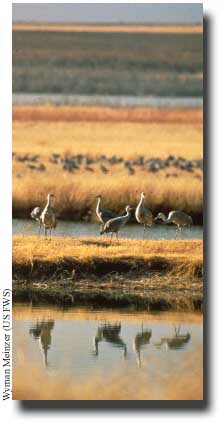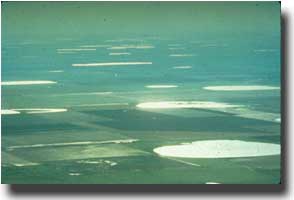Playa Lakes

Description
Playa lakes are round hollows in the ground in the Southern High Plains of the United States. They are ephemeral, meaning that they are only present at certain times of the year. The temporal nature of playa lakes led to confusion on the part of early European explorers, some of whom described the region as a desert and others a land of millions of small lakes. Most playas fill with water only after spring rainstorms when freshwater collects in the round depressions of the otherwise flat landscape of West Texas, Oklahoma, New Mexico, Colorado, and Kansas. There are also a few saltwater-filled playas. These are fed by water from underlying aquifers, which brings salt with it as it percolates up through the soil. As the water evaporates, the salt is left behind in the increasingly salty playas. There are many theories as to the origin of playas, but the most widely accepted are that playas are either carved by wind or formed by land subsidence (they are sinkholes). Whatever their origin, playas are important to humans, animals and plants of the High Plains. You can find out more information about playa lakes at the Playa Lakes Joint Venture.


Functions & Values
Playas are important because they store water in a part of the country that receives as little as twenty inches of rain a year and where there are no permanent rivers or streams. Consequently, playas support an astounding array of wildlife. Two million waterfowl commonly winter in the playa lakes of the Southern High Plains. Mayflies, dragonflies, salamanders, Bald Eagles, endangered Whooping Cranes, jackrabbits and raccoons also can be found at playa lakes. Amphibians would not be present in this arid region if it were not for playas. Because playa lakes support such a wide variety of animals, they contribute significantly to the biodiversity of the High Plains. The surrounding land is mostly dedicated to a few agricultural species, and some species native to the High Plains survive only because of the existence of playa lakes. Playas also help support the surrounding agriculture by providing irrigation water and seasonally recharging the Ogallala Aquifer. This famous aquifer underlies the Southern High Plains and is being used for irrigation and drinking water faster than it is being replenished.
Status
Today, some playas are appreciated and protected because of their value to wildlife. Playas' importance as water storage sites is also recognized - they provide between 10 and 25 percent of the annual irrigation water in some counties. To protect this water source from pollution, many farmers are adopting playa-friendly farming techniques like planting native vegetation around playas to filter sediment, fertilizer, and pesticides from the runoff that provides playas' water supplies. Sediment in runoff can fill playas, reducing their capacity to hold water and depleting biodiversity. An emerging threat to playas is that some farmers in the Southern High Plains are returning to dry farming techniques, which means less rainwater reaches playas. Some new irrigation methods can lead to decreases in the amount of water reaching playas as well, by altering runoff patterns. In some places, playas are still used as lagoons to hold animal waste, which seriously decreases their ability to support wildlife and can threaten groundwater purity.
